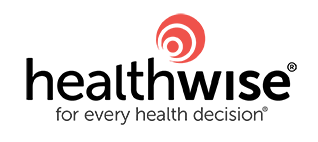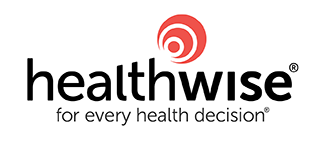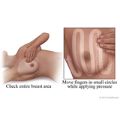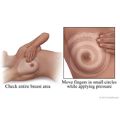Test Overview
A breast self-examination involves checking your breasts for lumps or changes. Many breast problems are first discovered by women themselves, often by chance. Breast lumps can be non-cancerous (benign) or cancerous (malignant).
Breast cancer can occur at any age, though it is most common in women older than 50. Lumps or changes also may be signs of other breast conditions, such as mastitis or a fibroadenoma.
The Canadian Task Force on Preventive Health Care does not recommend breast self-examinations for women ages 40 to 74 who do not have a higher risk of breast cancer.footnote 1 Studies show that self-examinations don't save women's lives and that they can lead to unneeded tests, such as biopsies. It is a good idea to become familiar with how your breasts look and feel and to talk to your doctor about any changes.
How It Is Done
The best time to examine your breasts is usually 1 week after your menstrual period starts, when your breasts are least likely to be swollen or tender. Examining your breasts at other times in your menstrual cycle may make it hard to compare results of one examination with another.
If your menstrual cycle is irregular, or if you have stopped menstruating due to menopause or the removal of your uterus (hysterectomy), do your examination on a day of the month that's easy to remember.
A breast self-examination normally doesn't cause any discomfort. If your breasts are tender because your menstrual period is about to begin, you may feel slight discomfort when you press on your breasts.
To do a breast self-examination:
- Remove all your clothes above the waist.
- Lie down.
Lying down spreads your breasts evenly over your chest and makes it easier to feel lumps or changes.
- Check your entire breast by feeling all of the tissue from the collarbone to the bottom of the bra line and from the armpit to the breastbone.
Use the pads of your three middle fingers—not your fingertips.
- Use the middle fingers of your left hand to check your right breast.
- Use the middle fingers of your right hand to check your left breast.
You can use an up-and-down pattern or a spiral pattern. Move your fingers slowly in small coin-sized circles.
- Use three different levels of pressure to feel all of your breast tissue.
- Light pressure is needed to feel the tissue close to the skin surface.
- Medium pressure is used to feel a little deeper.
- Firm pressure is used to feel your tissue close to your breastbone and ribs.
- Avoid lifting your fingers away from the skin as you feel for lumps, unusual thicknesses, or changes of any kind.
In addition to examining your breasts while lying down, you may also check them while in the shower. Soapy fingers slide easily across the breast and may make it easier to feel changes. While standing in a shower, place one arm over your head and lightly soap your breast on that side. Then, using the flat surface of your fingers—not the fingertips—gently move your hand over your breast, feeling carefully for any lumps or thickened areas.
It takes practice to perform a breast self-examination. Having fibrocystic lumps also may make a breast self-examination difficult, because lumps occur throughout the breast. Ask your doctor for tips that can help you do it correctly.
When in doubt about a particular lump, check your other breast. If you find the same kind of lump in the same area on the other breast, both breasts are probably normal.
Next steps
After you know what your breasts normally look and feel like, any changes should be checked by a doctor. Changes may include:
- Any new lump. It may or may not be painful to touch.
- Unusual thick areas.
- Sticky or bloody discharge from your nipples.
- Any changes in the skin of your breasts or nipples, such as puckering or dimpling.
- An unusual increase in the size of one breast.
- One breast unusually lower than the other.
Remember that most breast problems or changes are caused by something other than cancer.
Even if you choose to do breast self-examinations, talk to your doctor about having regular mammograms as well as regular breast checkups at your doctor's office or the mammogram centre.
Risks
The risk of doing breast self-examinations is that you may find a breast change that makes you anxious and may lead to unnecessary tests (such as a biopsy).
Also, a change you notice on a breast self-examination may be a kind of cancer that would never cause symptoms or threaten your life. But because no one can tell what kinds of cancer will cause problems, all cancers are treated. This means that you may end up having treatments (such as surgery, radiation, and chemotherapy) that you don't need. These treatments can cause harmful side effects.
Because of these risks, many experts don't recommend breast self-examinations. Others consider it an option for women. Talk with your doctor about breast self-examinations.
Related Information
References
Citations
- Canadian Task Force on Preventive Health Care (2018). Recommendations on screening for breast cancer in women aged 40–74 years who are not at increased risk for breast cancer. CMAJ, 190(49): E1441–E1451. DOI: 10.1503/cmaj.180463. Accessed December 20, 2018.
Credits
Current as of: August 2, 2022
Author: Healthwise Staff
Medical Review:
Kathleen Romito MD - Family Medicine
Martin J. Gabica MD - Family Medicine
E. Gregory Thompson MD - Internal Medicine
Wendy Y. Chen MD, MPH - Medical Oncology, Hematology
Current as of: August 2, 2022
Author: Healthwise Staff
Medical Review:Kathleen Romito MD - Family Medicine & Martin J. Gabica MD - Family Medicine & E. Gregory Thompson MD - Internal Medicine & Wendy Y. Chen MD, MPH - Medical Oncology, Hematology



